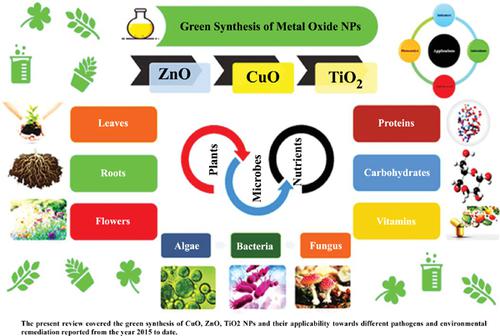Current Analytical Chemistry ( IF 1.8 ) Pub Date : 2021-09-30 , DOI: 10.2174/1573411017999201125124513 Sagar Panhwar 1 , Jamil A. Buledi 1 , Dadu Mal 1 , Amber R. Solangi 1 , Aamna Balouch 1 , Ali Hyder 1

|
Background: Nanotechnology is a promising field of science which deals with the production and utilization of material under nanoscale dimensions. The nanoscale regime provides exceptional applications in various fields of science due to its large surface to volume ratio and many valuable properties. Hence, the production and use of nanomaterials are the prominent areas of modern research. Amongst the nanomaterials, metal oxide NPs have gained much attention due to their vast number of applications in different areas, including electrochemical applications, dye degradation, catalysis, and are known to be the exceptional entities in the battle against different pathogens. The metal oxides are viably synthesized through chemical methods that require the use of many noxious chemicals. Henceforth, it is the demand of the modern world to carry out research on the synthesis of metal oxide nanomaterials through eco-friendly, greener, and non-toxic routes. Thus, various green methods are employed to engineer the metal oxide NPs by using different greener, cheaper, and eco-friendly sources, employing the use of plant extracts, bacteria, fungi and other biological bodies. The present review covered the green synthesis of CuO, ZnO, TiO2 NPs and their applicability towards different pathogens and environmental remediation reported from the year 2015 to date.
Objective: The exceptional catalytic properties, environmental, and anti-microbial applications of metal oxide, especially CuO, ZnO, TiO2, are the main highlights of this review articles. The most cost-effective and greener routes for the synthesis of CuO, ZnO, TiO2, are discussed in the present review. To date, various green synthetic methods for the preparation of mentioned nanoparticles and their applicability towards different pathogens and degradation of different hazardous dyes with some electrochemical applications has been thoroughly covered in this review.
Conclusion: The biosynthesis of metal oxide NPs using greener and eco-friendly approaches have been the attentive area in the last decade. Green synthesis requires chemical-free active components from biological sources, which act as both the reducing and stabilizing agent for the size and shapecontrolled production of NPs. The future vision of bacterial, fungal, and plant-mediated production of NPs includes the postponement of laboratory-based work to a large industrial scale, exposition of different phytochemicals involved in the biosynthesis of NPs using bioinformatics techniques and stemming the real mechanism involved in preventing the growth of pathogenic bacteria, fungi, and algae. The plant-mediated NPs can have diverse applications in the arena of pharmaceutical, food, and cosmetic industries, and thus, became a vital area of modern research.
中文翻译:

铜、锌、钛氧化物纳米颗粒绿色合成策略的重要性和分析视角及其在病原体和环境修复中的应用
背景:纳米技术是一个很有前途的科学领域,它涉及纳米尺度下材料的生产和利用。由于其大的表面积与体积比和许多有价值的特性,纳米级方案在各个科学领域提供了特殊的应用。因此,纳米材料的生产和使用是现代研究的突出领域。在纳米材料中,金属氧化物纳米颗粒因其在不同领域的广泛应用而备受关注,包括电化学应用、染料降解、催化,并且被认为是对抗不同病原体的特殊实体。金属氧化物是通过需要使用许多有毒化学品的化学方法合成的。今后,通过环保、绿色、无毒的途径合成金属氧化物纳米材料是现代世界的需求。因此,通过使用不同的更绿色、更便宜和环保的来源,利用植物提取物、细菌、真菌和其他生物体,采用各种绿色方法来设计金属氧化物纳米粒子。本综述涵盖了从 2015 年至今报道的 CuO、ZnO、TiO2 NPs 的绿色合成及其对不同病原体和环境修复的适用性。真菌和其他生物体。本综述涵盖了从 2015 年至今报道的 CuO、ZnO、TiO2 NPs 的绿色合成及其对不同病原体和环境修复的适用性。真菌和其他生物体。本综述涵盖了从 2015 年至今报道的 CuO、ZnO、TiO2 NPs 的绿色合成及其对不同病原体和环境修复的适用性。
目的:金属氧化物,尤其是 CuO、ZnO、TiO 2的卓越催化性能、环境和抗微生物应用是本综述文章的主要亮点。本综述讨论了合成 CuO、ZnO、TiO 2的最具成本效益和更环保的路线。迄今为止,本综述已经全面涵盖了用于制备上述纳米颗粒的各种绿色合成方法及其对不同病原体的适用性以及具有一些电化学应用的不同危险染料的降解。
结论:在过去十年中,使用更绿色环保的方法生物合成金属氧化物纳米颗粒一直是人们关注的领域。绿色合成需要来自生物来源的不含化学物质的活性成分,这些成分既是纳米颗粒大小和形状受控生产的还原剂和稳定剂。细菌、真菌和植物介导的 NPs 生产的未来愿景包括将基于实验室的工作推迟到大规模工业规模,使用生物信息学技术展示参与 NPs 生物合成的不同植物化学物质,并阻止参与预防的真正机制病原菌、真菌和藻类的生长。植物介导的 NPs 在制药、食品和化妆品行业有多种应用,因此,



























 京公网安备 11010802027423号
京公网安备 11010802027423号